Mother Huang He
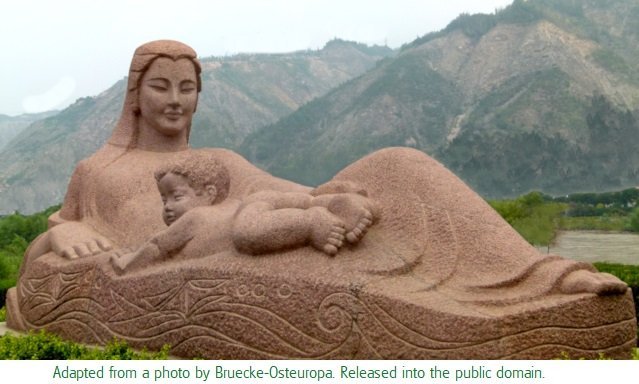
Can there be a more benign, more comforting image than Mother Huang He, cradling her infant? The infant represents the birth of China's civilization. And Mother Huang He represents the Yellow River, which is called Huang He in Chinese. The river has been central to life in China for millennia. While it has given life, it has also taken life, with ferocious determination. Some of the greatest catastrophes in human history have occurred because of Yellow River flooding.
Hence, the paradoxical, alternate name for the river: China's Sorrow.
This great river---the second largest in China, sixth largest in the world--was not always yellow. It was endowed with this color by the sediment it carries, called loess. While other rivers in the world carry loess, concentrations are especially high in the Yellow River. Why?
Two researchers from Rice University reported that Yellow River loess is so fine, it offers very little physical resistance to water and is therefore carried along easily.
Hukou Waterfall, on the Yellow River
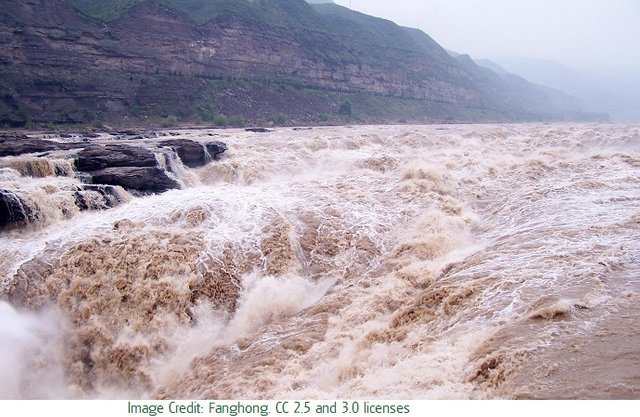
Much of this loess comes from a region in China called the Loess Plateau. Although the plateau gave rise to one of China's earliest civilizations, by the dawn of the twentieth century, people could barely scratch out a living on this 'cradle of civilization'. According to ecologists, the decline was a direct result of human activity.
The ecological degradation of the plateau occurred in stages. In ancient times fertile land was cleared for habitation and cultivation. This was the first stage. Then, farmers planted crops year after year on the same terrain. They did not understand that soil nutrients could be depleted in this way. Eventually, overuse resulted in poorer and poorer crop yields. Finally, when the land was no longer suitable for agriculture, people began to herd animals. This was the final blow to the ecology of the plateau.
Grazing animals can strip an area of vegetation. When they graze, the animals often pull up plants by the roots. As mature plants become scarce, the animals turn to immature plants. By doing so, they destroy the next generation of growth, and the earth is laid bare.
Grazing Animals Can Degrade Soil and Vegetation
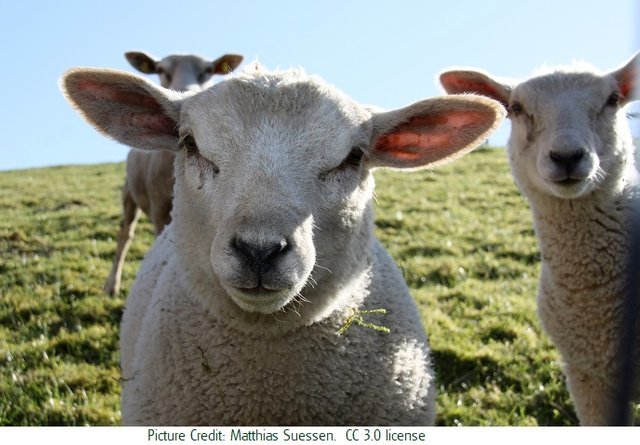
Stripping of the land through grazing rapidly advances the process of desertification. The Loess Plateau no longer had plants that could hold water. The plateau's fine, loamy silt washed away easily. Wind further eroded soil that had not been carried off by rain and runoff.
Loess Landscape, Shanxi Province, China
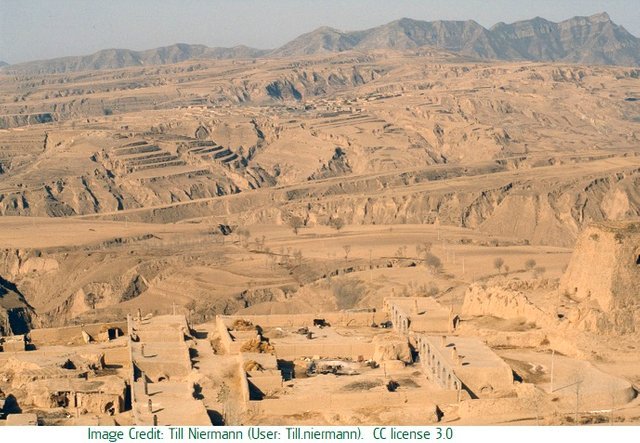
Loess May Be Found in Fertile and Barren Regions
Loess exists all over the world. It covers about 10% of the earth. It is found on windswept desserts, and also forms the basis for fertile farmland. In the absence of vegetation, fine silt particles may be carried away by the wind. In this way, it is believed, sand from the Gobi Desert traveled with the wind and settled on the Loess Pleateau.
The lack of vegetation on the Loess Plateau distinguishes it from other areas rich in loess, such as the Pampas of South America and the Danube Basin of Europe.

Regreening the Loess Plateau:Turning Back Time
If the absence of vegetation has rendered the Loess Plateau barren, can new vegetation be established, and the plateau restored? Ecologists and land use planners believe this can happen. Regreening the plateau will take a number of steps. Work has begun and is already bearing 'fruit'. The undertaking will not only benefit people who live on the plateau. It will also serve as a model for others who have suffered similar ecological damage.
Step #1: Terracing
Terraced Development
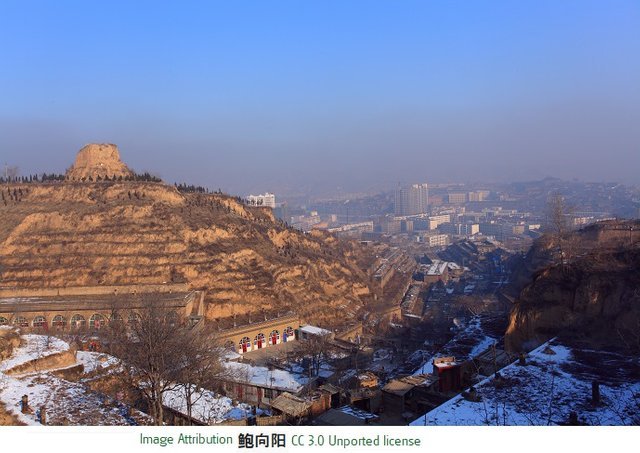
One of the first steps in regeneration is to stabilize soil and stop the runoff of silt. Terracing the land and establishing plants on each level will help to slow the flow of water, and retain soil. A benefit of terracing is that it does not require heavy machinery. As this video from the World Bank shows, the local people can do the work themselves. They can create terraces by using hand tools.
As the new plants take root, they stabilize the soil. They will not only hold water, but through transpiration, will return moisture to the atmosphere. About 10% of the water released into the atmosphere comes from plant transpiration.
Transpiration

This is part of the water cycle: evaporation of water from terrestrial sources; cloud formation; rain.

Picture adapted from Jozefsu, on Wikimedia Commons: The Edge of the Loess Plateau CC 4.0 License
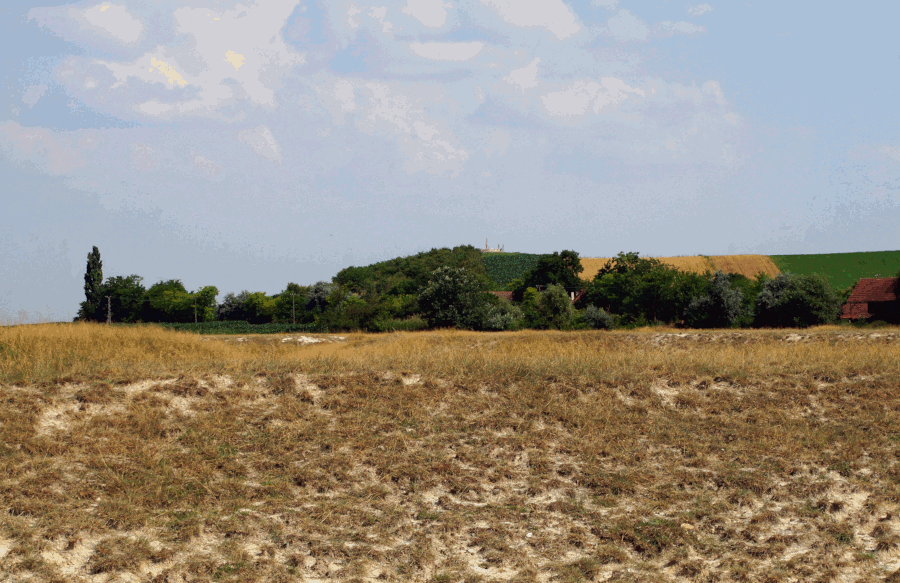
Environmentally Appropriate Vegetation
It has long been believed that the Loess Plateau was once a lush forested area. Research suggests that this may not have been the case. A pollen analysis, that looks at different geological eras, reveals that forests were not typical of the area. Rather, the plateau had a steppe-like ecology. Aforestation--the attempt to create forests on the plateau--might be doomed to failure.
Juglans (Walnut) Plant: A Good Candidate for Cultivation on the Plateau?
According to an article published in the Journal of Applied Ecology, negative consequences of aforestation are already evident. These consequences include "low tree survival rate, increased soil erosion,exacerbated water shortages and deep soil desiccation". The authors of the article suggest that selecting steppe-appropriate foliage would insure long-term ecological success. This sort of vegetation would also be the basis for a sustainable economy.
Several plant species that might be grown for profit are suggested. These include maple and walnut. Not only could these plants be marketed as food, but they also could be marketed as sources of conventional and traditional medicines. Of the many medicines mentioned in the article, two stood out for me: Paclitaxel (a cancer treatment) and artemis-inin (an anti-malarial).

Yellow River Breaches Its Course
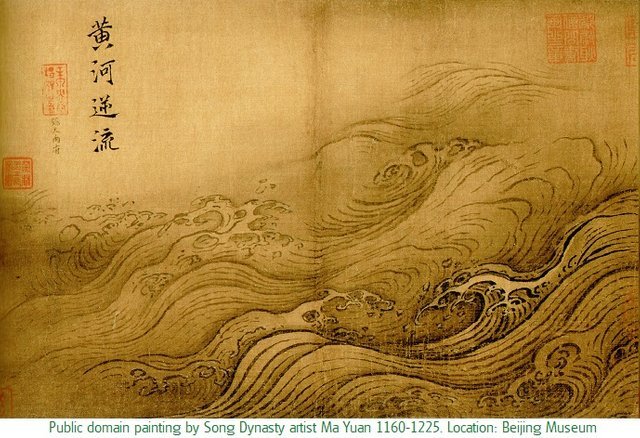
With the reestablishment of vegetation on the Loess Plateau, and the decrease in soil erosion, it is believed there will be a secondary effect: mitigation of flooding.
Yellow River flooding looms large in the collective memory of the Chinese people. The legend of the Great Flood, a multi-year inundation, has been partly supported by recent archeological finds. There is an established relationship, particularly in the Yellow River, between silt and flooding.
As silt washes into the river, it raises the river floor. The higher the floor, the more readily waters will flood over the banks if water is introduced quickly, say through heavy rainfall. Not only does the floor of river rise with silt accumulation, but natural dams also build up from silt. These dams eventually give way under pressure and the sudden release of water inundates surrounding lands.
Sometimes, the force of flooding water is so great that the course of the river changes. This has happened to the Yellow River several times over the centuries. The picture at the top of this section (Yellow River Breaches Its Course) shows just such a course change during the Song Dynasty. The picture below shows different courses the river took over the span of centuries.
Yellow River Water Course Changes
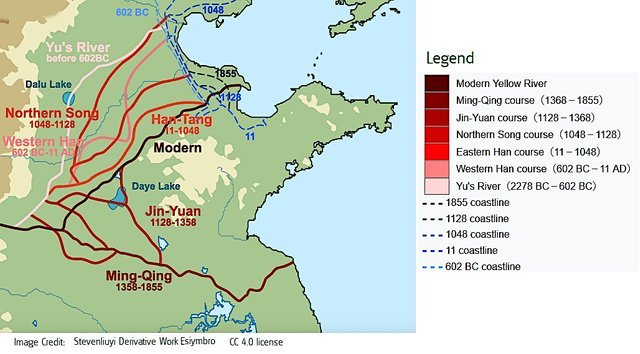
If there was less soil erosion, and less silt deposit in the river, the tendency for natural dams to develop would decrease. With less dams, there would likely be a reduced risk of catastrophic inundations. Even when humans intervene and attempt to alter the flow of the river with the construction of artificial dams, the effort tends to fail because of silt accumulation.
The Sanmenxia Dam: Flushing Silt
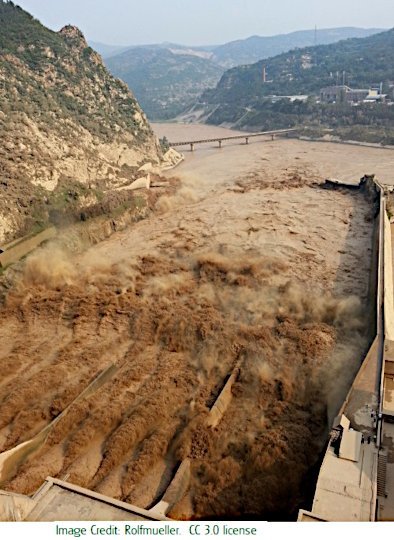
The Sanmenxia Dam, completed in 1960, encountered difficulties after construction, partly because of silt accumulation.


The story of China is, in a way, the story of its rivers. And the
story of the Loess Plateau, is, in a way, a story of the Yellow River.
It is hard to tell these stories without seeing the implications for all
of us. I hope I conveyed that relevance as I told my own version of
these stories.

Thank you for reading and spending time with me

Steem on!


Some Sources Used in Writing This Blog:
The Conversation: https://theconversation.com/confucian-thought-and-chinas-environmental-dilemmas-35585
Britannica: https://www.britannica.com/science/loess
South China Morning Post: https://www.scmp.com/news/china/society/article/2094153/why-chinas-yellow-river-so-yellow-and-why-its-prone-flooding
World Agriculture: http://www.world-agriculture.net/files/pdf/agroecosystem-management-in-arid-areas-under-climate-change-experiences-from-the-semiarid-loess-pla.pdf
Conservation Institute: https://www.conservationinstitute.org/what-is-overgrazing/
Soils Matter: https://soilsmatter.wordpress.com/2018/06/15/why-do-the-loess-hills-of-iowa-need-to-be-farmed-in-terraces/
Nature: https://www.nature.com/articles/s41598-018-37635-y
World Bank: https://www.worldbank.org/en/news/feature/2007/03/15/restoring-chinas-loess-plateau
Science Direct: https://www.sciencedirect.com/science/article/pii/S0016706113001742
US Geological Survey: https://www.usgs.gov/special-topic/water-science-school/science/evapotranspiration-and-water-cycle?qt-science_center_objects=0#qt-science_center_objects
Landscape for Life: https://landscapeforlife.org/soil/how-to-determine-soil-type/
Ravine Lands: Greening for Livelihood and Environmental Security:https://books.google.com/books?id=13ZZDwAAQBAJ&pg=PA25&lpg=PA25&dq=forested+areas+of+ancient+loess+plateau&source=bl&ots=KFM3FD60QY&sig=ACfU3U1JFfGx0SyTI31LhjZlnZW9F_hbHQ&hl=en&sa=X&ved=2ahUKEwjKpd286I3lAhVmTd8KHQ7JCxk4FBDoATABegQICRAB#v=onepage&q=forested%20areas%20of%20ancient%20loess%20plateau&f=false
Bes Journals: https://besjournals.onlinelibrary.wiley.com/doi/epdf/10.1111/1365-2664.12052
Archeology.org: https://www.archaeology.org/issues/233-1611/trenches/4914-trenches-china-xia-dynasty-flood
Jstor.org: https://www.jstor.org/stable/3060335?seq=1#page_scan_tab_content
China Dialogue: https://www.chinadialogue.net/article/show/single/en/3796-Muddy-waters
Water, Technology and Nation State: https://books.google.com/books?id=Z79aDwAAQBAJ&pg=PT373&lpg=PT373&dq=Sanmenxia+dam+engineer+imprisoned&source=bl&ots=ovuuyoRlz4&sig=ACfU3U1n3huaCZqeTp1plUa2RxgxIrR1Fg&hl=en&sa=X&ved=2ahUKEwjA3ZTbnJDlAhWqmOAKHULsC6oQ6AEwDXoECAgQAQ#v=onepage&q=Sanmenxia%20dam%20engineer%20imprisoned&f=false
NASA: https://pmm.nasa.gov/education/water-cycle
Science Direct: https://www.sciencedirect.com/science/article/pii/S1877705816319592
U Mass, Boston: http://blogs.umb.edu/buildingtheworld/waterworks/the-grand-canal-china/
Jstor: https://www.jstor.org/stable/jamewatworass.106.5.e225?seq=1#page_scan_tab_contents
Jstor: https://www.jstor.org/stable/jamewatworass.106.5.e225?seq=1#page_scan_tab_contents
The China Story: https://www.thechinastory.org/ritp/chinas-sorrow/
World Agriculture: http://www.world-agriculture.net/files/pdf/agroecosystem-management-in-arid-areas-under-climate-change-experiences-from-the-semiarid-loess-pla.pdf
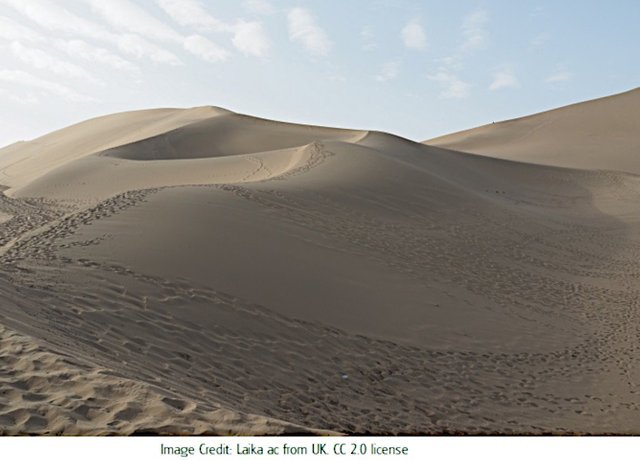
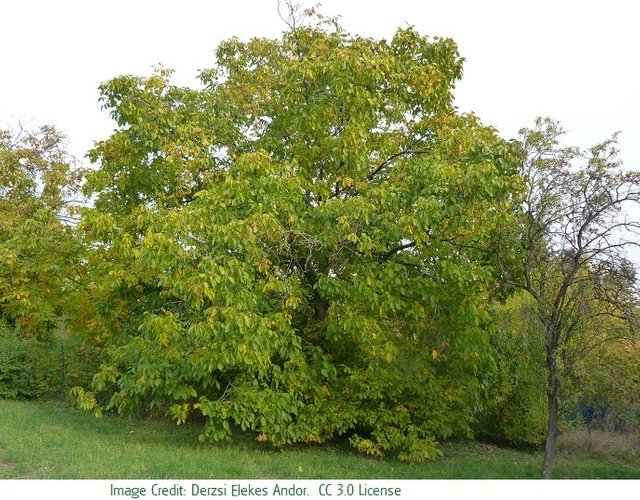
China is probably a land where the people often were confronted with serious problems.
Today, I heard, they are threatened by a lack of water because of deforestation happened decades ago. Therefore, agriculture is not "fluid" enough and this may cause trouble.
Nevertheless, as shown in this article here they will find a way, as every time in their long long history, to solve even the worst obstacles.Good morning @agmoore, and thank you for this nice insights into Chinese history and culture.
Have a nice weekend
Chapper
Hi Chapper,
Thanks so much for the kind words. Your comment touches on an aspect of the blog I would have dwelt on, except I didn't want to be tedious (for readers). As I read different sources, I became very interested in the water cycle, in how local vegetation can actually affect rainfall. I have in mind a continuation, a second blog, that addresses aspects of the issue I left out.
China is a fascinating subject--and its relationship with the West has been complex for centuries--bias and misunderstanding on both sides. My ambition (in the past) has been to find bridges between the cultures that would courage people to see similarities, rather than differences.
Have a wonderful weekend. I know you will use your time wisely, so I won't tell you to rest. Just have fun :)
Warm regards,
AG
Wow, what a great article! Good work and very interesting. Nature is nature and we hav to respect it and live together with it. Nature wins of course... resteem and greetings LGG
So much research. I learn so much--it's hard to leave stuff behind. But tomorrow is another day. Time for another post. See the influence you have had on me?
Hope you are well and peaceful. I appreciate your kind comments. (And thanks for the resteem)
Regards,
AGHello, @gaich. Thank you! Sometimes, when I write now I remember one of your comments: stop writing :))
I am sorry that my words make you think about your doing... it is your life and if it is a great joy to research a whole night... you can do that and don't thimk about gaich's comments. "Listen to all - follow none." It is the voice of your heart that wants to be heard not the voice of gaich hehe. ;-) In german we have an expression "Mach dein Ding" Do it your way ... And you can decide that this comment is good and not the other one "stop writing"... Or booth are nonsence ;-))) That is life - easy complicating
Feel your heart - don't think so much and "mach dein Ding!" ;-))))
Regards Gaich
Hey, Gaich: no worries! I came of age in the 60s. I've been doing my own thing for a long time. It's taken the wisdom of age to teach me that sometimes good advice should get an ear. That's how I took your comment. Your good intentions always come through.
Be well, happy, and always do your own thing (but sometimes listen to friends)
Edit: I just upvoted my own comment :))
Hehe,
you are doing your own thing ;-)))) Thank you for your nice comment - have a nice week! LGG Thank you for the music, old-fashioned but making me smile...
Hehe, now i understand why you have not posted for a while. You have been busy and as i know you, you want to make it perfect. You succeed - very good post - thank you! Best wishes Kadna
Hello Kadna! Thank you. I listened to you and Gaich. Shorter posts, but still a lot of research. I love the research, I just don't torture readers with it anymore :))
Hope you are well and happy. Nice to see you here.
Regards,
AG
Yes, i feel fine! Thank you.
I know and i like that (because i can't do such work) ;-) Steem on! Kadna
🌞🌷
This is a great write-up. I learned a lot on topics I am interested in! First, I must say that it is funny to read about the cradle of civilisation in China. Mentally, I connect it to the true cradle, in South Africa (that I had the chance to visit).
Many have still not understood this, unfortunately. Or they did but don’t care. Profit should come first.
This being said, China is doing more and more for the planet. And we should all be happy with that (I am sure @mobbs could comment with more facts). On the personl side, day after day I learn new things about what China does. Here, I actually didn’t know about their work on the Loess Plateau (that I even didn’t know to exist before reading your post).
Thank you, @lemouth. It was @mobbs' blog about China that piqued my interest. I did a lot of research a couple of years ago on the Yuan Dynasty (art) and remembered that the dynasty came to an end for many reasons--one was a disastrous flood. I started looking into what caused the flood, and learned about the Loess Plateau.
So glad the blog reads well. Hope @mobbs approves...he's the China expert :)
As for learning about what benefits the planet, and putting profit above social good:
Frustrating, isn't it?
I appreciate your nice comment. Research and writing are rewarding, but not so much in a vaccum. Positive feedback helps:)
Very frustrating :(
I suspect that the ignorance of farmers also stems from the fact that in times of taxes (the tenth crop yield or other forms), they have learned to exploit the soil in order to produce sufficient yields. Over the centuries, land has been cleared for agriculture and rootless soil is blown away by the wind. Unless the legacy of the forefathers helped teach that topsoil is precious and microbiology takes time, this knowledge has probably been lost over time. Knowlegge gets disrupted by crisis, war or other catastrophes, so I think where this happened, it might be that survival and fear could be responsible for losing knowledge.
I think that many effects build up over the years and then become visible much later. As we know, the effects in nature come about with a time lag. The farmers are probably the least responsible. Self-suppliers are likely to be exploitative only if their environment does the same and you are pushed into a system that sees profit first. Smallholders who cultivate their land by hand or with animals are caught in a vicious circle if they cannot draw on knowledge and joint efforts to prevent the devastation of areas.
I think the information is now in the hands of the locals. An education campaign is underway. There is also an incentive program to allow ownership, so that the yield from the land will directly benefit the farmers and it will be in their self interest to use optimal farming practices.
Your point is well taken: In times of want, one doesn't worry about saving seed for the future, or preserving soil for next season. One worries about eating. Survival is a strong motivator.
I am totally for self help and learning how to cultivate nature with the least damaging methods. If this meets self interest, that is probably the best of combinations.
I agree. All of this is connected to the "boundary conditions". Relax the pressure and things may get easier back to normal, although we may have been too far in many cases.
Just to specify what I meant when I wrote "many". It may sound that this "may" is applicable to the farmers, but this is actually applicable to most people in general. So yeah, once again thanks for the clarification! ;)
That's the question, isn't it? I sometimes wonder where it's too far/late ... but then of course, I can think of a few. But I am glad, best practices are shown and researched, so that people do not lose hope and orient themselves on this better practice examples. We certainly need them all.
Oh, and yes, the potential to act where the profit points at is embedded in each of us, I agree. It's an act of will to work against it, I'd say :)
Absolutely beautiful work my dear friend. As usual!
This is all new information to me. How wonderful to obtain all this understanding through such a well researched and carefully illustrated article. Not only have you succeeded in informing us how the history of China and that of its nature are so tightly intertwined, but also in making us think about the rippling effects they have.
The observation you made about research indicating that the decline of the Loess Plateau results from human activity, immediately brought to mind the events that took place on Easter Island, which I believe you are familiar with (all the devastation caused by men.)
Also, I found quite incredible to read about floods being so powerful to the point of changing the course of the river! My goodness! Nature is truly not to be messed with. The opening with Mother Huang He and the river's paradoxical name, is very touching :)
Thank you my dear for taking the time to bring all this info to us <3
Much love always and forever :*
Thank you, dear friend. So much of this is new to me, also :)) It seems to be that I am always looking for mountains to climb--can't pick stuff I know--it's always something I don't know. An adventure, each time.
Yes, Easter Islands. I am aware, but rusty. Of course, this means I go back to refresh. I do remember reading about George, the oldest turtle, who was all alone and recently died.
What I find fascinating about Mother Huang He and China's Sorrow: People can hold these two sentiments at the same time. We are complex creatures, aren't we?
You are so kind to read and compliment my blog. You know you are one of the audience I hold in mind when I write. It's a standard that helps me to keep working even when material is challenging.
You warm my heart. Thank you.
With great affection,
AG
I was equally impressed to hear about the re-naturalization on the Loess Plateau when I was looking at the work of John D. Liu, who documented the problem described. You can find it on youtube:
It very much depicts what your article is describing. Glad to read that you support the efforts which have been made and spread them. Though I haven't heard much about Mr. Liu since.
Hi and Bye from good old Germany :)
I love that video. I think you might have recommended Liu to me before... or maybe I came across him in my research.
Thanks, Erica, for stopping by and for endorsing my research. Fascinating subject, isn't it.
Hope you are well and happy :)
Regards,
AG
Yes, that could very well be. I often recommend the people I once found on youtube or elsewhere. This fittet too well:)
The subject is fascinating, true. I feel inspired ever so often by characters like Liu or others who put so much love and care into their works.
I am well, thank you. Right now I am more inward oriented. Maybe it's a mixture of autumn, thinking of relationships resp. reflecting time as now the right season starts and nothing else distracts me from doing it.
I hope, your spirits are good and you too are well.
Hug you.
🌼 🌼 🌞
This post has been voted on by the SteemSTEM curation team
and voting trail. It is elligible for support from @curie and @minnowbooster.
If you appreciate the work we are doing, then consider supporting our witness @stem.witness. Additional witness support to the curie witness would be appreciated as well.
For additional information please join us on the SteemSTEM discord and to get to know the rest of the community!
Thanks for having used the steemstem.io app and included @steemstem in the list of beneficiaries of this post. This granted you a stronger support from SteemSTEM.
Thank you, SteemSTEM,
I'm honored.
@tipu curate 0.5
Upvoted 👌
Thank you 😇
Thank you, very much!
Great post, you deserve more support ;-)
It took two weeks! Every bit of it fun. But it's so nice to receive appreciation. Thank you, again.
You're most welcome! Keep up the good work!
This post was shared in the Curation Collective Discord community
community witness. Please consider using one of your witness votes on us here for curators, and upvoted and resteemed by the @c-squared community account after manual review.@c-squared runs a
Wow! Thank you. I'm having a great Thursday.
I appreciate the support, very much.
Hello!
This post has been manually curated, resteemed
and gifted with some virtually delicious cake
from the @helpiecake curation team!
Keep up the great work!Much love to you from all of us at @helpie!
Manually curated by @veryspider.
Community Witness.
@helpie is a
Thank you, very very much. I love those visuals. Go straight to the cupboard :)
Congratulations @agmoore2! You have completed the following achievement on the Steem blockchain and have been rewarded with new badge(s) :
You can view your badges on your Steem Board and compare to others on the Steem Ranking
If you no longer want to receive notifications, reply to this comment with the word
STOPVote for @Steemitboard as a witness to get one more award and increased upvotes!